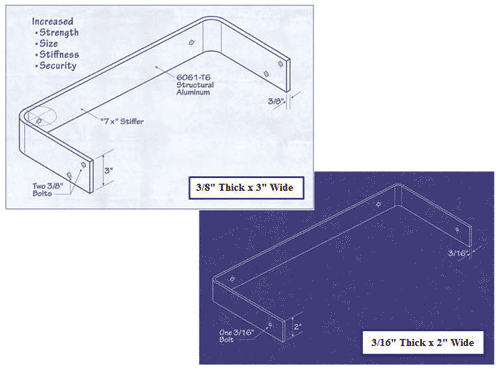Reaching the Roof: Specifying Fixed Access Aluminum Ladders for Safety and Efficiency
Ladder brackets. Critical features of a fixed access ladder are the ladder brackets that anchor the ladder to the structure. As with the composition of ladder material, the aluminum grade of the brackets is crucial, as are the number of brackets and their size, for ensuring a safe, secure and ergonomic ladder system. The use of high strength aluminum alloy 6061-T6 provides stiffer brackets which means less deflection when the ladder is being used. Installing two 3/8-inch bolts rather than a single 3/16-inch bolt on each side to attach the bracket to the ladder further enhances security.
When specifying ladders, architects should note the grade of aluminum to be used in manufacturers' specs. This, and other details of materials, should be determined by the specific requirements of the installation and the need for long term durability. Different aluminum alloys are compatible with each other, but strengths do vary. For example, 6061-T6 is a heat-treated alloy that has the equivalent strength of mild structural steel. A properly designed ladder system will have the structural members all supporting their share of the load while not exceeding the material strength of the alloy.

Larger-sized ladder brackets add strength, stiffness and security to ladder installation
Ergonomics
Ideally, the design and construction of fixed access aluminum ladders should reflect the ergonomics of climbing ladder steps.
Vertical ladders. For vertical ladders fixed at 90 degrees, round rungs provide a stronger, more comfortable grip when pulling up. Round rungs also provide a more natural support for the feet, which pivot while climbing straight up. Ideally, rungs should have a serrated surface for a no-slip grip and be secured to the side rails with cast aluminum connectors, using four solid aircraft rivets on each rung. This gives a permanent, no-twist installation that has a combined shear strength of over 3,600 pounds for each rung. For anchoring strength, fixed ladders should come with mounting brackets that are 3/8-inch thick aluminum bar, pre-punched to provide 16-in. on center mounting holes. Brackets should be provided for every six feet in length of the fixed ladder.
Angled ladders. For angled ladders, flat steps give the best support when climbing at an angle. Ships and folding ladders should be available with steps of varying depths. To best suit climbers' feet, ladders with a greater angle from the floor—60 degrees for example—should have a greater depth. Steps should also be permanently affixed to the side rails using eight solid rivets per step, with non-slip ridges on the top. Flush or extended handrails need to be designed to fit the users' hands, giving a comfortable grip when steadying the body during climbing.










